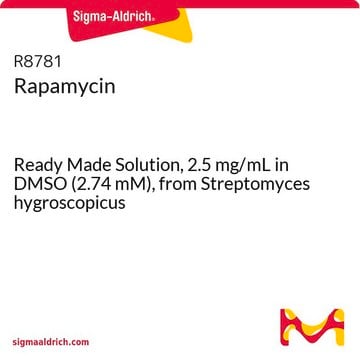475991
Torin1
≥99% (HPLC), powder, mTOR inhibitor, Calbiochem®
Sinónimos:
mTOR Inhibitor XI, Torin1, 1-(4-(4-propionylpiperazin-1-yl)-3-(trifluoromethyl)phenyl)-9-(quinolin-3-yl)benzo[h][1,6]naphthyridin-2(1H)-one, DNA-PK Inhibitor VI, PI 3-K Inhibitor XVIII
About This Item
Productos recomendados
Nombre del producto
mTOR Inhibitor XI, Torin1, mTOR Inhibitor XI, Torin1, CAS 1222998-36-8, is a cell-permeable, highly potent, ATP-competitive inhibitor of mTOR and DNA-PK (IC50 = 4.32 and 6.34 nM, respectively).
Nivel de calidad
Ensayo
≥99% (HPLC)
Formulario
powder
potencia
2 nM IC50
fabricante / nombre comercial
Calbiochem®
condiciones de almacenamiento
OK to freeze
protect from light
color
yellow-white
solubilidad
DMSO: 2 mg/mL
Condiciones de envío
ambient
temp. de almacenamiento
2-8°C
cadena SMILES
FC(F)(F)c1c(ccc(c1)[n]3c4c5c(ncc4cc[c]3=O)ccc(c5)c6cnc7c(c6)cccc7)N2CCN(CC2)C(=O)CC
InChI
1S/C35H28F3N5O2/c1-2-32(44)42-15-13-41(14-16-42)31-11-9-26(19-28(31)35(36,37)38)43-33(45)12-8-24-20-40-30-10-7-22(18-27(30)34(24)43)25-17-23-5-3-4-6-29(23)39-21-25/h3-12,17-21H,2,13-16H2,1H3
Clave InChI
AKCRNFFTGXBONI-UHFFFAOYSA-N
Descripción general
Acciones bioquímicas o fisiológicas
MTOR
Envase
Advertencia
Reconstitución
Otras notas
Thoreen, C., et al. 2009. J Biol Chem.284, 8023.
Información legal
Código de clase de almacenamiento
11 - Combustible Solids
Clase de riesgo para el agua (WGK)
WGK 2
Punto de inflamabilidad (°F)
Not applicable
Punto de inflamabilidad (°C)
Not applicable
Certificados de análisis (COA)
Busque Certificados de análisis (COA) introduciendo el número de lote del producto. Los números de lote se encuentran en la etiqueta del producto después de las palabras «Lot» o «Batch»
¿Ya tiene este producto?
Encuentre la documentación para los productos que ha comprado recientemente en la Biblioteca de documentos.
Los clientes también vieron
Nuestro equipo de científicos tiene experiencia en todas las áreas de investigación: Ciencias de la vida, Ciencia de los materiales, Síntesis química, Cromatografía, Analítica y muchas otras.
Póngase en contacto con el Servicio técnico









